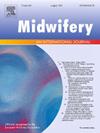妊娠期恶心和呕吐的个体间变异的预测因子在两个参加妊娠诊所的妇女样本中。
IF 2.6
3区 医学
Q1 NURSING
引用次数: 0
摘要
问题:妊娠期恶心和呕吐的病因尚不清楚。背景:以往的研究表明,其发病率和严重程度受许多不同因素的影响,包括人口、生活方式和社会心理因素。目的:本研究旨在检测多种因素(联合口服避孕药(COC)是否与父亲见面、胎儿性别、怀孕年龄、胎次、受教育程度、生活水平/收入、孕前吸烟和体重指数)对妊娠期恶心和呕吐水平的影响。方法:我们从捷克共和国同一妊娠诊所的两个独立样本中收集数据(研究1,N = 448;研究2,N = 508),并使用两种不同的方法设计测试了多种因素的影响:回顾性自我报告(研究1)和对其当前状态的自我报告(研究2)。研究结果:在研究1中,我们发现在遇到伴侣时使用COC的女性以及怀孕前吸烟的女性报告的恶心和呕吐程度较低。在研究2中,我们发现年轻女性和家庭收入较高的女性有相对严重的NVP症状。讨论:我们讨论了两种方法方法的优缺点,因为我们在两个其他可比较的样本中发现了不同的预测因子。结论:我们建议未来的研究采用纵向设计,并结合妊娠期恶心和呕吐的当前和回顾性测量。本文章由计算机程序翻译,如有差异,请以英文原文为准。
Predictors of inter-individual variation in nausea and vomiting in pregnancy in two samples of women attending a pregnancy clinic
Problem
The aetiology of nausea and vomiting in pregnancy is still not well understood.
Background
Previous research suggests that its incidence and severity are influenced by many different factors, including demographic, lifestyle and psychosocial factors.
Aim
This study aimed to test the effect of multiple factors (use of combined oral contraception (COC) on meeting the father, sex of the foetus, age when pregnant, parity, education, life standard/income, smoking before pregnancy and BMI) on levels of nausea and vomiting in pregnancy.
Methods
We collected data from two independent samples of women attending the same pregnancy clinic in the Czech Republic (Study 1, N = 448; Study 2, N = 508) and tested the effect of multiple factors using two different methodological designs: retrospective self-report (Study 1) and self-reports on their current state (Study 2).
Findings
In Study 1, we found that lower levels of nausea and vomiting were reported by women who used COC when they met their partner, as well as in those who smoked before pregnancy. In Study 2, we found that younger women and women who reported higher household income had relatively severe NVP symptoms.
Discussion
We discuss the pros and cons of the two methodological approaches, as we found different predictors in two otherwise comparable samples.
Conclusion
We suggest that future studies use longitudinal designs and combinations of both current and retrospective measures of nausea and vomiting in pregnancy.
求助全文
通过发布文献求助,成功后即可免费获取论文全文。
去求助
来源期刊

Midwifery
医学-护理
CiteScore
4.50
自引率
7.40%
发文量
221
审稿时长
13.4 weeks
期刊介绍:
Midwifery publishes the latest peer reviewed international research to inform the safety, quality, outcomes and experiences of pregnancy, birth and maternity care for childbearing women, their babies and families. The journal’s publications support midwives and maternity care providers to explore and develop their knowledge, skills and attitudes informed by best available evidence.
Midwifery provides an international, interdisciplinary forum for the publication, dissemination and discussion of advances in evidence, controversies and current research, and promotes continuing education through publication of systematic and other scholarly reviews and updates. Midwifery articles cover the cultural, clinical, psycho-social, sociological, epidemiological, education, managerial, workforce, organizational and technological areas of practice in preconception, maternal and infant care.
The journal welcomes the highest quality scholarly research that employs rigorous methodology. Midwifery is a leading international journal in midwifery and maternal health with a current impact factor of 1.861 (© Thomson Reuters Journal Citation Reports 2016) and employs a double-blind peer review process.
 求助内容:
求助内容: 应助结果提醒方式:
应助结果提醒方式:


